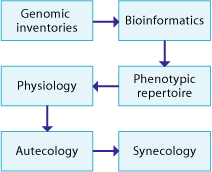- C-MORE Home
- Member Area
- What is Microbial Oceanography?
- What is C-MORE?
- C-MORE Hale
- Research
- Theme I: Microbial Biodiversity
- Theme II: Metabolism and C, N, P & Energy Flow
- Theme III: Remote and Continuous Sensing; Links to Climate Variablilty
- Theme IV: Ecosystem Modeling, Simulation, and Prediction
- Research Cruises
- Data
- Education & Outreach
- People
- Publications
- Microscopy Images
- Professional Development Training Program
- Summer Course
- C-MORE Highlights
- Meeting Facilities
- Contact Us
 Research Themes
Research Themes
Theme IV: Ecosystem modeling, computer simulation and prediction

Scott C. Doney (Theme IV Leader)
Woods Hole Oceanographic Institution (WHOI)
Beyond the challenge of understanding contemporary ecosystem dynamics is the anticipation and prediction of future changes in ocean ecology. There is now ample and growing evidence to suggest that major changes in the structure of the NPSG can occur over decadal time scales. This altered view of biogeochemical dynamics in the ocean may have a profound influence on how one thinks about marine planktonic ecosystems, including the potential impacts of natural or human-induced environmental change and its relationship to carbon sequestration. For example, N2 fixation may be controlled by the atmospheric deposition of Fe and the degree of surface ocean stratification, both of which are variable, climate sensitive parameters. Total atmospheric dust transport is also affected by humankind, including population demographics, global economies and land use patterns. These complex natural and anthropogenic interactions, with multiple potential feedback loops, provide a mechanism for biogeochemical variability in otherwise “stable and homogeneous” biomes.
The response of marine food webs to environmental changes cannot be based on the predictions of static models whose parameters are chosen based on the goodness of fit of model output to currently observed phenomena. The reason is that communities of organisms are adaptive. In order to understand how biological communities adapt, it is first necessary to understand the principles that drive the organization of those communities.
 Modeling forms one of the Center’s four research thrusts. The modeling thrust will involve a hierarchy of models that link
information and knowledge among research thrusts to provide an understanding of the role of microbes in the ocean ecosystem.
The food web and export models that will be used in C-MORE are indeed non-linear in nature. The figure to the right illustrates a pathway
leading from gene sequencing to synecology (food webs, energy flow, and nutrient cycles). In each box depicted in the figure, models
assimilate and integrate the information/understanding provided by the previous level in the sequence and output
information/understanding needed by the next level. During the first five years of C-MORE, it is expected that information and
understanding derived from the study of model organisms will provide much of the basis for developing the model thrust from gene
sequencing through autecology. Combining the understanding of autecology with the information and understanding derived from themes
II and III will then provide the input for the synthesis and modeling component, i.e., theme IV and synecology.
For this transformation of information and understanding to proceed smoothly, it will be critical that the problems to
be resolved by the modeling thrust be well defined and that the input/output requirements of models at successive levels be coordinated.
Modeling forms one of the Center’s four research thrusts. The modeling thrust will involve a hierarchy of models that link
information and knowledge among research thrusts to provide an understanding of the role of microbes in the ocean ecosystem.
The food web and export models that will be used in C-MORE are indeed non-linear in nature. The figure to the right illustrates a pathway
leading from gene sequencing to synecology (food webs, energy flow, and nutrient cycles). In each box depicted in the figure, models
assimilate and integrate the information/understanding provided by the previous level in the sequence and output
information/understanding needed by the next level. During the first five years of C-MORE, it is expected that information and
understanding derived from the study of model organisms will provide much of the basis for developing the model thrust from gene
sequencing through autecology. Combining the understanding of autecology with the information and understanding derived from themes
II and III will then provide the input for the synthesis and modeling component, i.e., theme IV and synecology.
For this transformation of information and understanding to proceed smoothly, it will be critical that the problems to
be resolved by the modeling thrust be well defined and that the input/output requirements of models at successive levels be coordinated.
Most extant food web models attempt only a very crude representation of microbial processes in the ocean. For example, many food web models do not include heterotrophic bacteria as a functional group, choosing instead to simply parameterize the effect of heterotrophic bacterial processes on nutrient cycling and energy flow. Some models still characterize phytoplankton as a single functional group, although in recent years it has been common to partition phytoplankton into large and small size classes. Efforts to model the impact of Trichodesmium and other diazotrophs on nitrogen fixation have met with mixed success. One of the central hypotheses of C-MORE is that inclusion of a more representative collection of functional microbial groups within food web models will allow us to address fundamental issues in marine science that have not been resolvable with existing models. These issues include, for example, regime shifts in nutrient limitation (e.g., nitrogen versus phosphorus versus iron), the impact of episodic nutrient delivery on the trophic status (autotrophic vs. heterotrophic) of the open ocean, the length scale of nutrient remineralization within the mesopelagic zone, and the relative importance of nitrogen fixation on ocean carbon and nutrient cycling.
[ Top of Page ]



